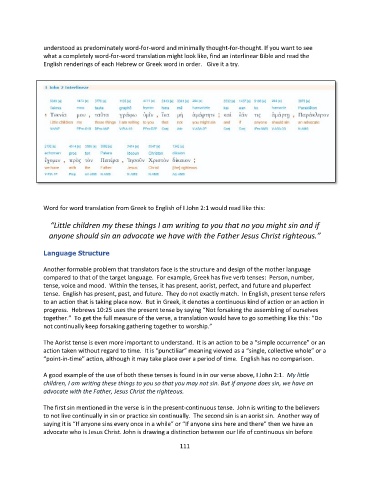Page 113 - Doctrine and History of the Preservation of the Bible revised
P. 113
understood as predominately word-for-word and minimally thought-for-thought. If you want to see
what a completely word-for-word translation might look like, find an interlinear Bible and read the
English renderings of each Hebrew or Greek word in order. Give it a try.
Word for word translation from Greek to English of I John 2:1 would read like this:
“Little children my these things I am writing to you that no you might sin and if
anyone should sin an advocate we have with the Father Jesus Christ righteous.”
Language Structure
Another formable problem that translators face is the structure and design of the mother language
compared to that of the target language. For example, Greek has five verb tenses: Person, number,
tense, voice and mood. Within the tenses, it has present, aorist, perfect, and future and pluperfect
tense. English has present, past, and future. They do not exactly match. In English, present tense refers
to an action that is taking place now. But in Greek, it denotes a continuous kind of action or an action in
progress. Hebrews 10:25 uses the present tense by saying “Not forsaking the assembling of ourselves
together.” To get the full measure of the verse, a translation would have to go something like this: “Do
not continually keep forsaking gathering together to worship.”
The Aorist tense is even more important to understand. It is an action to be a “simple occurrence” or an
action taken without regard to time. It is “punctiliar” meaning viewed as a “single, collective whole” or a
“point-in-time” action, although it may take place over a period of time. English has no comparison.
A good example of the use of both these tenses is found in in our verse above, I John 2:1. My little
children, I am writing these things to you so that you may not sin. But if anyone does sin, we have an
advocate with the Father, Jesus Christ the righteous.
The first sin mentioned in the verse is in the present-continuous tense. John is writing to the believers
to not live continually in sin or practice sin continually. The second sin is an aorist sin. Another way of
saying it is “If anyone sins every once in a while” or “If anyone sins here and there” then we have an
advocate who is Jesus Christ. John is drawing a distinction between our life of continuous sin before
111

